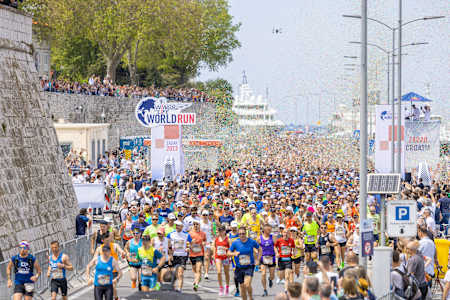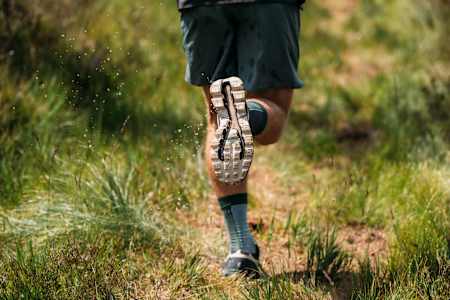
Marathon
These running tips from pros will help you bag your first marathon
Planning to run your very first marathon? These tried and tested tips from our endurance athletes will help you to reach that marathon finish line.
Running a marathon is a complex undertaking. Not only because 26.2 miles is quite the distance, but the road to the start of your first marathon alone requires targeted planning as well as suitable training. After all, if you want to run a marathon, you have to prepare your body and mind for the upcoming exertions. With these tips from top athletes, you will succeed!
And what better place to put those tips into practice than at world's largest running event? Take on the Wings for Life World Run on May 5, 2024, in its one-of-a-kind format and aim to go the distance to show the Catcher Car what you've got.
Here are 8 tried and tested tips for a successful marathon:
- Define a concrete goal
- Run for a cause
- Invest in the right running shoes
- Plan your running training
- Do some strength training to go with it
- Optimize your nutrition and hydration
- Improve your sleep and recovery
- Plan your race day
01
Define a specific goal
Before you attempt your first marathon, you should set yourself a clearly defined and, above all, realistic goal. Running your first marathon in under three hours is utopian and may never be achievable for most of us. Instead, your first goal should be to complete your first marathon - regardless of the time! Instead of setting a target time at the beginning, choosing a marathon in your area that you want to start and complete is better. Plan enough time for your preparation, at least 16 weeks.
02
Run for a cause
Wings for Life World Run: Moving us closer to a cure for spinal cord injury
© Tomislav Moze for Wings for Life World Run
Move for good. Training for a marathon is no small challenge, but lacing up your shoes for a cause you care about can add a whole new level of motivation to your preparation. Run for a purpose you care about, whether that's choosing a charity close to your heart, raising awareness of an issue you're passionate about, supporting an individual person or running in memory of a loved one.
If you choose to take part in the Wings for Life World Run, you'll support spinal cord injury research, transforming each mile into meaningful action. The annual event is a global run for everyone, connecting runners, walkers and wheelchair users wherever they are in the world with its unique format. Participants compete simultaneously in the race with no finish line; it's the famous 'Catcher Car' that determines the end of your race when it overtakes you!
Join a flagship run, or wherever you are in the world – literally – via the app to join in at your own pace and as per your personal goals.
The extra boost of of knowing you're running for a good cause can help push through those toughest of training days and celebrate your finish line moment with a deeper sense of accomplishment.
03
Invest in suitable running shoes
Buying new and properly fitting running shoes has many advantages. Not least, new running shoes will motivate you to achieve your race goal. But more importantly, the perfect running shoe is fun to wear, takes the strain off your musculoskeletal system and prevents injuries and overuse.
Of course, you should also like the look of your running shoe, but more important than color and appearance is that you feel comfortable in your running shoes and that your foot gets the support it needs to remain stable over longer distances.
So, while new technologies such as carbon fiber panels in the midsole are the norm for the running elite (at least in competition), they are not the best choice for beginners and intermediates in doubt, and you should invest in better support properties instead of carbon fibre.
For triathlon ace Sebastian Kienle, there is no way around a visit to a specialist shop when it comes to suitable running shoes: "The best thing is to have a running analysis done at the start, then you know what you personally have to pay attention to and can ideally prevent injuries with the perfect footwear." The next step is to try out as many different models as possible until you have found the perfect running shoe for your first marathon - according to the motto: The proof of the pudding is in the eating!
Endurance ace Michael Strasser has another tip on running shoes: "Invest directly in two to three pairs of suitable and different running shoes, i.e. a pair for shorter distances, a pair for longer distances and possibly a pair of competition shoes and change them according to the different running sessions during the week - your feet will thank you for it!"
04
Plan your running training and boost your motivation
The first step is to set a realistic goal and sign up for your first marathon. Ideally, you have 16 weeks until the start to prepare yourself optimally. This is usually done in four 4-week cycles.
These cycles need to be well-planned and coordinated. When planning your training, you should also consider building motivation peaks by defining intermediate goals or small rewards after completing training sessions. Ideally, you should find a training partner following your 16-week plan. If a sudden motivation gap appears, you can help each other overcome it and get back on track.
Keep in mind that too much motivation can backfire and lead to overtraining and, ultimately, injury. When preparing for a marathon, you need to find a healthy balance between motivation, training and recovery.
The danger is always that you train too much. So pay attention and listen to your body!
- Training week 1-4: You get your body used to the training in the first four weeks. Accordingly, you will slowly feel your way up to the increasing running loads. A good start is two easy 30-minute runs during the week (e.g. Tuesday and Thursday) and a longer run at the weekend. Start your long runs with 40 minutes and add another 10 minutes each week. A moderate pace is absolutely fine for your long runs. It's all about building your endurance.
- Training week 5-8: In the second four weeks, you should add a tempo session to your two moderate runs during the week, running 30 minutes at a slightly faster pace. Continue to increase your long weekend run by 10 minutes per week. Once you reach 80 minutes, start measuring distance instead of time. Start with 9 miles and add another more each week. Always be careful not to overtrain. If in doubt, it is worth skipping a session.
- Training week 9-12: In the third 4-week block, you should extend your long runs to 15 miles. Try to run one of these sessions as a competitive half marathon – this will help you get used to running in a race with others and practice pacing yourself in the race, i.e. controlling your pace. Keep your three training sessions during the week, but replace one of your moderate running sessions with an interval session, where you run fast for four to five minutes and then slow down to almost walking speed for one minute. Repeat this six times, and you will feel a real endurance boost after a short time.
- Training week 13-16: Congratulations! Your training plan has reached its peak - and hopefully soon you will too. Complete your longest long run (approx. 21-25 miles) on the first weekend of the last 4-week block. After that, it's time to drastically reduce your training load. It's best to do a short interval session during the week and a maximum 60-minute run at a moderate pace on the weekend. In the last two weeks of training before your first marathon, you should also replace the weekend run with an interval session.
05
Do some accompanying strength training
Another often underestimated ingredient for a successful first marathon is a supportive strength training program in which you complete a variety of body-stabilizing exercises, or STSs, once a week. These include planks, side planks, push-ups and various squats, lunges, and glute bridges.
Only with a strong core can you eventually realize your dream of running a marathon.
"I am a big fan of accompanying strength training - especially the one without equipment," says Michi Strasser: "I believe that both strength training without and strength training with equipment have their justification for runners. Training without weights is especially important for runners to train their core," Strasser continues. You don't have to reinvent the world. But: "Only with a strong core can you realize your dream of a marathon at some point. And a strong torso is extremely important for injury prevention!"
06
Optimize your nutrition and drinking habits
Optimal nutrition and a solid drinking pattern before, during and after training sessions and competitions will increase your performance enormously! Your diet should be balanced, varied and nutritious, with a slight focus on carbohydrates before training and proteins after training. The following applies to food during exercise: "No matter what you consume, you have to test it extensively beforehand during training," Michael Strasser knows.
- Before training and competition: As an ambitious athlete, you should generally focus on whole-grain carbohydrates such as wholemeal bread, brown rice, fruit and vegetables, sweet potatoes, nuts, oatmeal and pasta. Before running, avoid meat and anything that will bloat you or put unnecessary strain on your digestion. This is especially true in the days leading up to your first marathon! Eat plenty of carbohydrates in the last two days before the start - this is also known as carb loading! This will ensure you are at the peak of your fitness to tackle the 26 miles with full power.
- During the run: To get the most out of training and competition, it is recommended to drink small amounts of fluids every 10 to 20 minutes. Care should be taken to supply the body with the appropriate electrolytes as to which mineral water is drunk, as the ingredients can vary greatly. Special attention should be paid to the electrolytes sodium, calcium and magnesium. When it comes to nutrition, you have to try out what works best for you. Some prefer special sports foods, others energy drinks and sports gels, and still others bananas, dried fruit or chocolate bars. "Another good combination is sugar and caffeine, for example, in the form of Red Bull," Sebastian Kienle knows from experience: "That always works wonders for me, especially towards the end of the race."
- After training and competition: After running, you need protein above all so that your muscles can regenerate and build up. Drinking a recovery shake in the first 15 to 20 minutes after exercise is advisable. Carbohydrates should also be included in your diet to replenish your reserves.
07
Improve your sleep and recovery
"Sleep is extremely important," emphasizes Michael Strasser. "If you don't sleep properly, you'll be pretty flat pretty soon." Not least because increased training activity increases the need for rest enormously. The best recipe for getting extra sleep, according to Strasser, is a short nap right after training. If you can't afford that, you should make sure that you at least get enough sleep at night, at least eight hours. Another important factor is the quality of sleep. The higher the quality of sleep, the greater the regeneration.
"Sleep is the regeneration booster par excellence," says Sebi Kienle. That's why you should optimize it. One way to do this is to maintain a consistent rhythm, i.e., going to bed and getting up at the same time. On the other hand, the right temperature in the bedroom - 18 degrees is considered ideal - and rituals that promote sleep: putting the mobile phone aside early, avoiding alcohol, and not completing intensive training sessions too close to bedtime.
Physical regeneration, especially of the legs, can best be improved by massages and regenerating baths and, last but not least, sufficient rest days between sessions.
08
Plan your race day
You should plan it well in advance to fully enjoy the day you have been training for and looking forward to for 16 weeks. It's best to do all the organizational things the day before: pack your bag with your running clothes and shoes, your race number, and especially your food the night before, and make a ritual out of it. It will calm your nerves and fuel your anticipation!
Plan enough time for your arrival to orientate yourself without stress, change your clothes and find your starting block and any fellow competitors. Then the hot phase begins, in which you should keep a cool head! The closer you get to the start, the more you should rely on the good training you have done.
A good race day plan also includes defining a target pace that you must stick to and a solid nutrition strategy. You should have tried and implemented the latter many times in your training sessions. Now, it's time to implement it under race conditions. The most important thing is to start eating early enough to keep your glycogen stores as full as possible. The same goes for drinking!
If everything goes as hoped, it is important to strictly adhere to the defined target pace, at least for the first 18 miles. Don't be tempted to run too fast too soon! After the 18 miles mark, other laws apply anyway, as Michael Strasser confirms: "A marathon is long enough to get to know yourself really well," he laughs. "In every marathon, probably the hardest phase comes between 25 and 30km when it hurts, and you don't like it any more. Overcoming this phase and then continuing to run is the real art of the marathon."
Why do we care about running? There are, of course, the mental and physical benefits of putting on a pair of trainers and stretching your legs, but the big one is our annual charity run, Wings For Life, which looks to raise funds to support spinal cord research. Every year, millions run globally for those that can't.
Run for those who can't in the 2024 Wings for Life World Run on May 5.
Part of this story



















